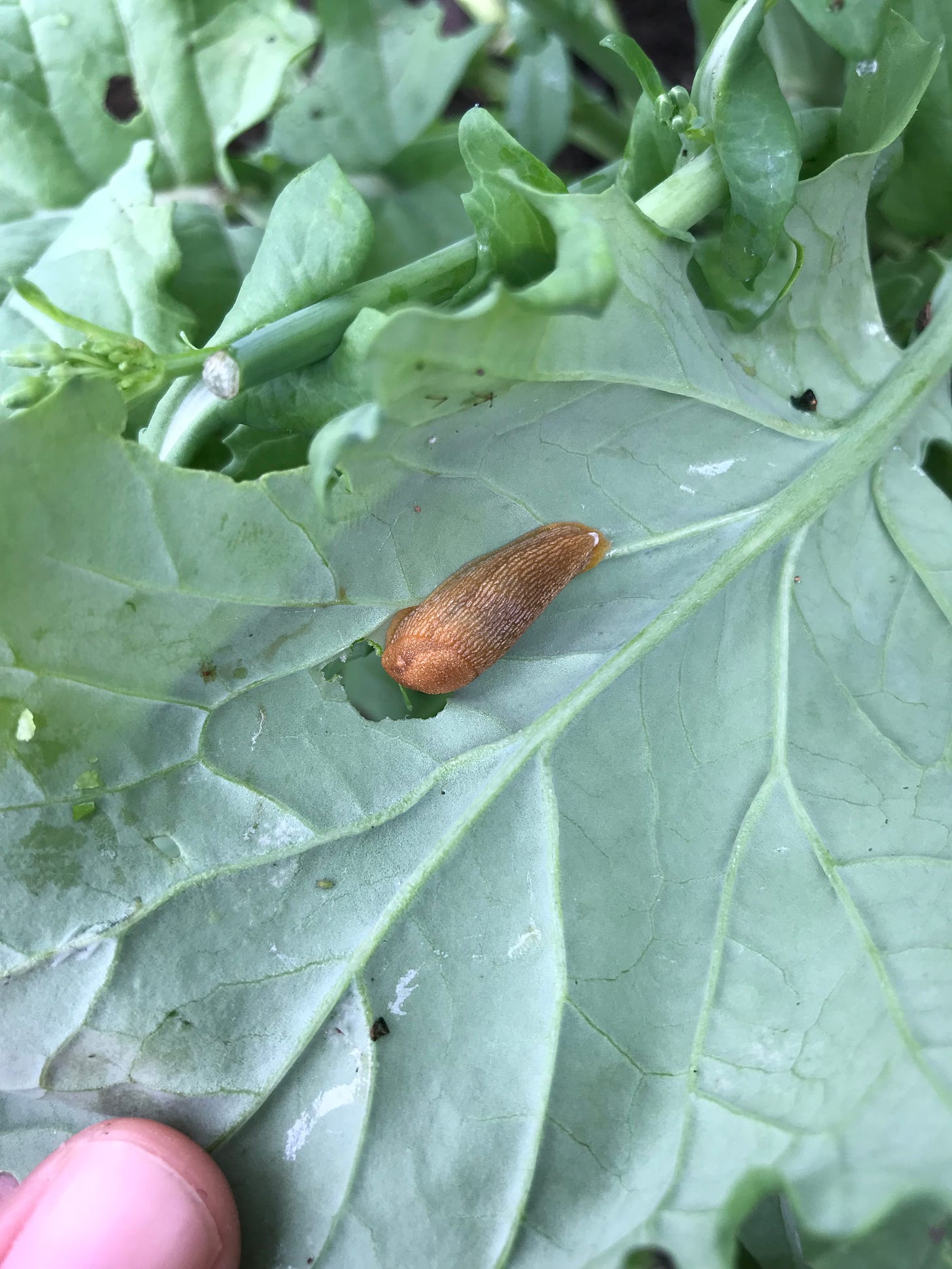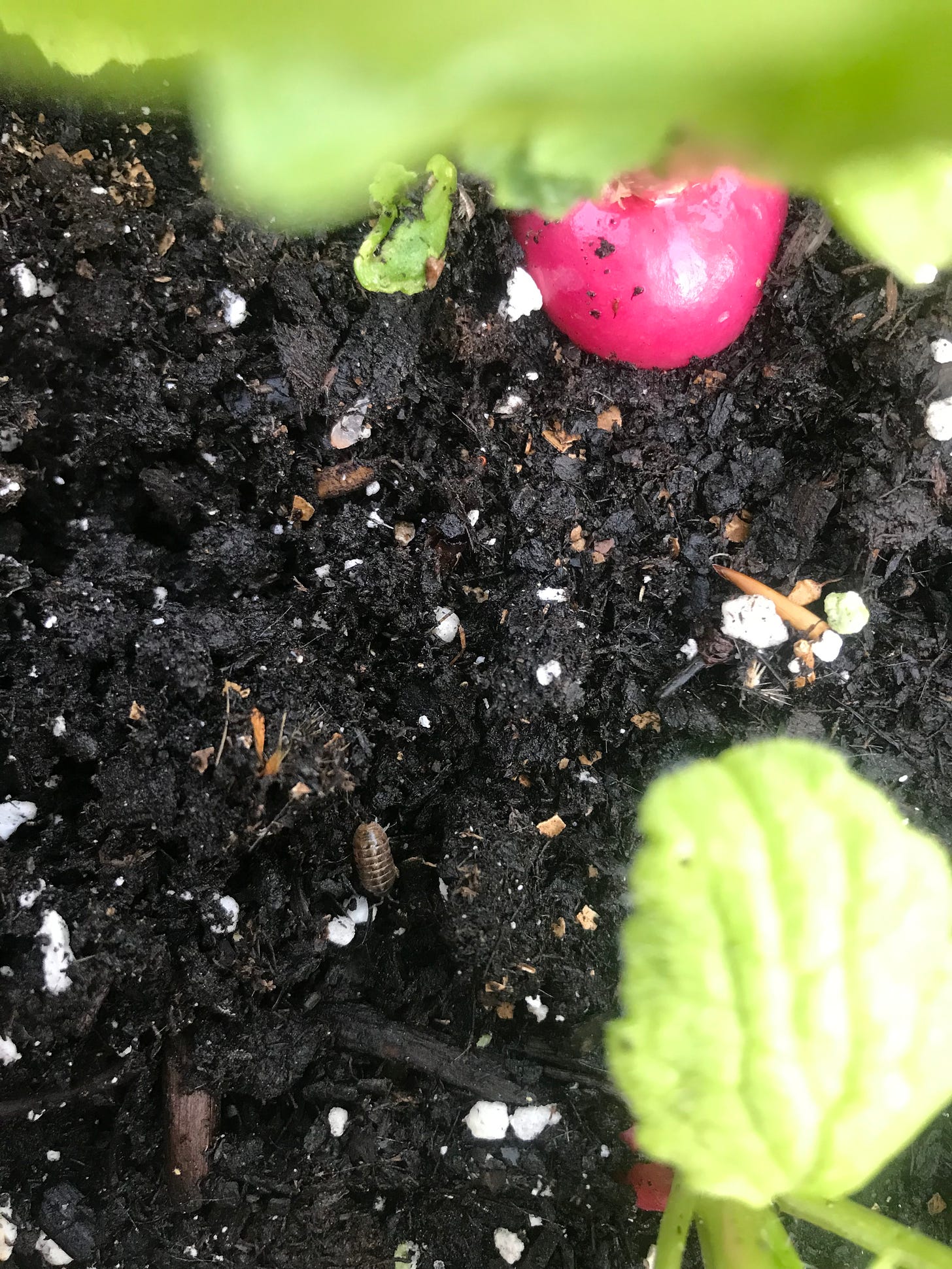For many gardeners, summer begins when the tomatoes are planted. I finally reached that milestone two weeks ago. We had such an odd spring here in Zone 7b — torrents of rain and very cool nights — and I was late in getting my tomatoes in the ground. The seedlings looked rough, and honestly I worried that they wouldn’t make it. They were in pots for far too long and looked anemic and reedy. But as soon as I got them out of their pots and into the soil, they started growing beautifully. It was a good lesson in the resilience of plants. I spotted the first fruits on my Apricot Zebra tomato plant over the weekend and I’m keeping tabs on them eagerly.
I’ve now entered the stage in the garden year that’s all about maintenance. The plants are in the ground, so now I just need to keep them healthy. That means fertilizing monthly, weeding around the base of plants, watering often, and of course monitoring and controlling for pests.
Over the last few months, I’ve been chronicling the insect visitors to my garden. Some are welcomed guests, and others are pests — at least in this setting. Here are a few of the insects I’ve hosted so far this year.
Pill Bugs
I know these as roly-polies. As a kid, I used to love flipping over rocks and watching a constellation of these bugs wriggle into motion. Look for them in damp parts of your garden, where they’ll be feasting on decaying organic matter. Pill bug infestations can happen and lead to lost or damaged crops, but that’s not typical. They’re a huge help help in composting. A fascinating fact: pill bugs are crustaceans! Apart from the similar-looking sow bug — which has two ‘tails’ and cannot roll up like pill bugs can — they are the only crustaceans that live fully on land.
Dusky Slugs
These, along with grey slugs, put me through the ringer this spring. With all the rainy, overcast weather, they had a field day. I always thought slugs didn’t enjoy eating nightshades, but this year I learned first-hand that that is incorrect. Watch for them on your peppers, tomatoes, and eggplants, as well as any plants with big leaves, such as lettuce, Swiss chard, and beets. I like to turn the leaves over and hand-pick as many as I can find. I had to rely heavily on beer traps this year as well. A fellow gardener recommended laying out empty plastic soil bags, weighed down so they don’t blow away. The slugs will be attracted to the dewy underside of the bag and they’ll hide out there during the day, where you can easily pick them off and remove them from your garden. If you don’t actually spot slugs, their calling card is leaving small, ragged holes in the middle of big leaves. I noticed them chewing into the edges of small leaves on my seedlings, too.
Slugs have been my number-one pest in the garden this year, but they are a tasty snack for birds, toads, turtles, and some beetles. This is one reason why your pest-prevention methods matter: A dead slug can easily end up as a bird’s dinner. Using non-toxic methods to control infestations keeps slugs’ predators healthy and able to keep helping us gardeners keep pest levels low.

Lady Bugs
These are a gardener’s best friend. As seen below, they’re big fans of tomatoes — as well as sweet corn, peas, beans, and more. Check the underside of the leaves for them, as they can be shy. Adult lady bugs eat nectar and pollen, so you can attract more to your garden by planting flowers and flowering shrubs. They also eat aphids, spider mites, and white flies, among other soft-bodied insects. You can even purchase bags of lady bugs to introduce to your garden as a natural pest-management system.
Striped Cucumber Beetle
These have done me dirty in past years. To date, my cucumber plants haven’t succumbed to them, even though they’re definitely experiencing some harm from them. Striped cucumber beetles are tricky because they can actually overwinter in your garden — in the soil, plant debris, or nearby woods. They’ll eat plants’ roots and stems as larvae and leaves, fruit, and petals as adults. As their name suggests, striped cucumber beetles are a particular threat to cucumbers, but they’ll go for any members of the cucurbit family, which includes watermelon and squash. They also like tree fruits like apples and pears and their blossoms, as well as okra, eggplant, and potatoes.
Look out for holes in leaves (see photo), flowers, and fruit. If you’ve ever noticed brown, scab-like damage on cucumbers and other fruits, that can be caused by these beetles. One reason to be on the lookout for these insects is that they can often introduce plant diseases such as cucurbit bacterial wilt and mosaic viruses. I have lost previously rigorous cucumber plants to cucurbit bacterial wilt and it’s very sad. The striped cucumber beetle also has a cousin: the spotted cucumber beetle. I’ve seen both in my garden in the past. Neem oil is supposedly a good means for protection, but I haven’t yet tried it myself.
Carpenter Bees
Let’s end on a high note, right? This weekend, I noticed my milkweed plants were just starting to bloom and the bees were already loving them. Native to my area, carpenter bees sustain themselves on nectar and pollen. They typically roam alone. Although they look quite similar in size and shape to bumble bees, carpenter bees have a smooth, black abdomen whereas bumble bees have a fuzzy one. Carpenter bees get their name from their nests: circular holes that they chew into wood. A finished nest resembles a tunnel some six to 12 inches and is often reused and sometimes even renovated from year to year. In the photo below, you see the carpenter bee feasting on a milkweed flower. This is an excellent sign, as milkweed relies on insects to cross pollinate. With any luck, this bee will have moseyed over to another flower on another milkweed plant and touched off the reproductive process.

Elsewhere in the garden:
My blackberry is fruiting this year! A gift from a colleague’s garden, it looked moribund all of last summer. I pruned it earlier this spring and it’s growing like crazy and is covered in future fruits.
My black-eyed Susan is expanding way too much and I’ll need to divide it.
The garden rabbits unfortunately got to my green beans before me :( I hope they at least enjoyed them!!







Thanks for this! I'm constantly looking up bugs and whether they're bad or good--I can never remember, and I wasn't quite sure about carpenters bees because we have a ton of them here, but now I'm glad we do. :)